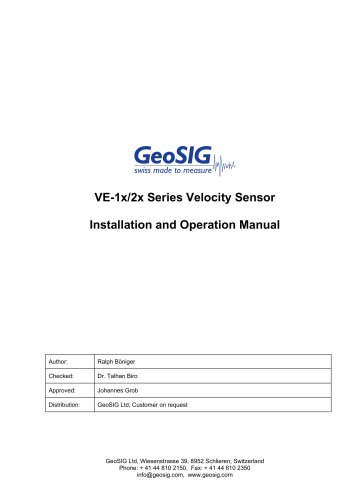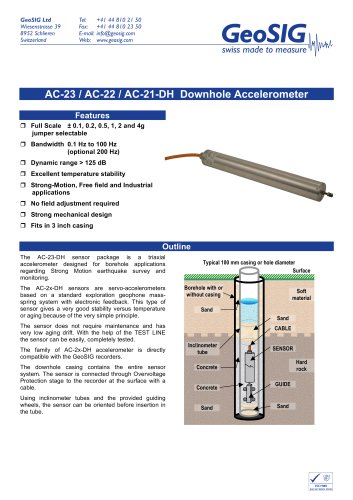
Catalog excerpts

GeoSIG Ltd, Wiesenstrasse 39, 8952 Schlieren, Switzerland Phone: + 41 44 810 2150, Fax: + 41 44 810 2350 info@geosig.com, www.geosig.com
Open the catalog to page 1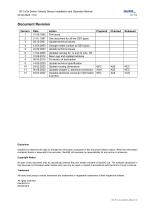
VE-1x/2x Series Velocity Sensor Installation and Operation Manual 03.03.2023 / V12 Document Revision Version Disclaimer GeoSIG Ltd reserves the right to change the information contained in this document without notice. While the information contained herein is assumed to be accurate, GeoSIG Ltd assumes no responsibility for any errors or omissions. Copyright Notice No part of this document may be reproduced without the prior written consent of GeoSIG Ltd. The software described in this document is furnished under license and may only be used or copied in accordance with the terms of such a...
Open the catalog to page 2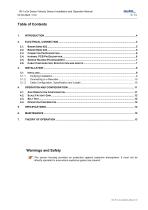
VE-1x/2x Series Velocity Sensor Installation and Operation Manual 03.03.2023 / V12 The sensor housing provides no protection against explosive atmosphere. It must not be directly operated in area where explosive gases are present.
Open the catalog to page 3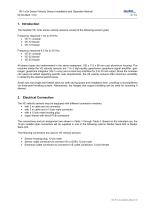
VE-1x/2x Series Velocity Sensor Installation and Operation Manual 03.03.2023 / V12 1. Introduction The GeoSIG VE-1x/2x series velocity sensors consist of the following sensor types: Frequency response 1 Hz to 315 Hz: • VE-11 uniaxial • VE-12 biaxial • VE-13 triaxial Frequency response 4.5 Hz to 315 Hz: • VE-21 uniaxial • VE-22 biaxial • VE-23 triaxial All sensor types are implemented in the same waterproof, 195 x 112 x 95 mm cast aluminium housing. The modules inside the VE velocity sensors are 1 to 3 high-quality geophones, geophone signal amplifier, gain ranger, geophone integrator (VE-1x...
Open the catalog to page 4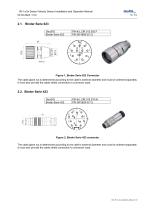
VE-1x/2x Series Velocity Sensor Installation and Operation Manual 03.03.2023 / V12 2.1. Binder Serie 623 GeoSIG Binder Serie 623 Figure 1, Binder Serie 623 Connector The cable gland nut is determined according to the cable’s external diameter and must be ordered separately. It must also provide the cable shield connection to connector case. 2.2. Binder Serie 423 GeoSIG Binder Serie 423 Figure 2, Binder Serie 423 connector The cable gland nut is determined according to the cable’s external diameter and must be ordered separately. It must also provide the cable shield connection to connector...
Open the catalog to page 5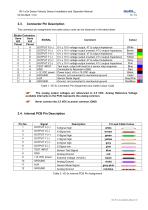
VE-1x/2x Series Velocity Sensor Installation and Operation Manual 03.03.2023 / V12 2.3. Connector Pin Description The connector pin assignment and cable colour code can be observed in the table below: Table 2. VE-3x Internal PCB Pin Assignment
Open the catalog to page 6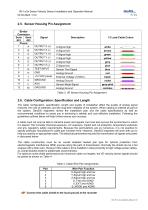
VE-1x/2x Series Velocity Sensor Installation and Operation Manual 03.03.2023 / V12 2.5. Sensor Housing Pin Assignment Binder Connector Table 3. VE Sensor Housing Pin Assignment 2.6. Cable Configuration, Specification and Length The cable configuration, specification, length and quality of installation affect the quality of analog signal received, the cost of materials, and the long-term reliability of the system. When cabling is ordered as part of the system, GeoSIG engineers review the installation plan and the cable specifications as well as environmental conditions to assist you in...
Open the catalog to page 7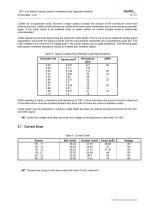
VE-1x/2x Series Velocity Sensor Installation and Operation Manual 03.03.2023 / V12 Cables do not generate noise. However, longer cables increase the amount of the contributed noise from external sources. Cables should always be routed as far from power distribution and control wiring as possible. Again, if the cable needs to be installed close to power cables, an overall braided shield is additionally recommended. Cable resistance primarily determines the maximum cable length. This is not an issue related to analog signal degradation since both the signal currents and the transmission...
Open the catalog to page 8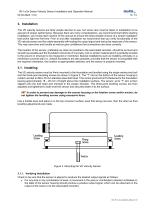
VE-1x/2x Series Velocity Sensor Installation and Operation Manual 03.03.2023 / V12 3. Installation The VE velocity sensors are fairly simple devices to use, but some care must be taken in installation to be assured of proper performance. Because there are many considerations, we recommend that before starting installation, you review each section of this manual to ensure the best possible chance of a simple installation that works right the first time. Prior to and after installation we recommend that you verify functionality of the VE velocity sensor and the cable assembly with testing the...
Open the catalog to page 9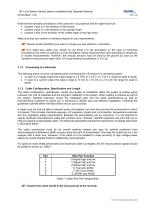
VE-1x/2x Series Velocity Sensor Installation and Operation Manual 03.03.2023 / V12 Note that the standard orientations of the axes are in accordance with the right-hand rule: • positive x-axis is in the direction of the thumb, • positive y-axis is in the direction of the pointer finger • positive z-axis in the direction of the middle finger of the right hand. Make sure that your sensor is oriented properly for your requirements. u2Sr° Please contact GeoSIG if you wish to change any axis direction /orientation. You might also utilise your sensor by not fixing it to the foundation (in the...
Open the catalog to page 10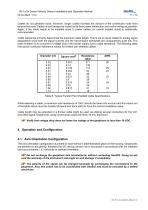
VE-1x/2x Series Velocity Sensor Installation and Operation Manual 03.03.2023 / V12 Cables do not generate noise. However, longer cables increase the amount of the contributed noise from external sources. Cables should always be routed as far from power distribution and control wiring as possible. Again, if the cable needs to be installed close to power cables, an overall braided shield is additionally recommended. Cable resistance primarily determines the maximum cable length. This is not an issue related to analog signal degradation since both the signal currents and the transmission...
Open the catalog to page 11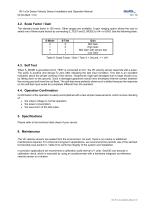
VE-1x/2x Series Velocity Sensor Installation and Operation Manual 03.03.2023 / V12 4.2. Scale Factor / Gain The standard scale factor is 100 mm/s. Other ranges are available. A gain ranging option allows the user to select one of three scale factors by connecting S_TEST and S_MODE to VA+ or GND. See the following table. Table 9. Scale Factor / Gain / Test; 0 = Ground, 1 = VA+ 4.3. Self Test When S_MODE is grounded and S_TEST is connected to VA+, the VE velocity sensor responds with a pulse. The pulse is positive and decays to zero after releasing the test input condition. This test is an...
Open the catalog to page 12All GeoSIG Ltd catalogs and technical brochures
-
GeoSwitch - Seismic Switch
2 Pages
-
GMSplus - GMSplus6
2 Pages
-
AC-4x Accelerometer
2 Pages
-
AC-2x Accelerometer
2 Pages
-
GeoDAS
1 Pages
-
SMS / SAS
2 Pages
-
Digital Sensor System
4 Pages
-
VE-5x-DH Seismometer
2 Pages
-
GMS NetQuakes Recorder
2 Pages
-
ETH-FLAN Ethernet Module
1 Pages
-
GeoSIG Company Brochure
1 Pages
Archived catalogs
-
GXX-3GMX Series 3G Router
1 Pages
-
GXX-3GUX Series 3G Modem
1 Pages
-
ETH-LLAN Ethernet Module
1 Pages
-
VE-3x Velocity Sensor
2 Pages
-
VE-1x Velocity Sensor
2 Pages
-
AC-7x-DH Accelerometer
2 Pages
-
AC-7x Accelerometer
2 Pages
-
AC-4x-DH Accelerometer
2 Pages
-
AC-2x-DH Accelerometer
2 Pages
-
VE-5x Seismometer
2 Pages

